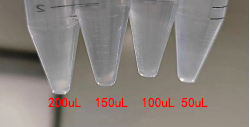Product Details
Product Details
Product Specification
| Usage |
Take a 24-well plate as an example 1. Sample preprocessing 1. Experimental materials: primary culture buffer B (pre-cooled at 4 ℃), tissue preservation solution E, sampling tube, tissue transport box and ice pack. 2. Sample sampling and transportation: The tissue should be put into tissue preservation solution E and primary culture buffer B within 30 minutes of isolation, washed 3-5 times, the blood on the tissue surface should be washed clean, put into tissue preservation solution E, and the sampling tube should be stored and transported at a low temperature of 4 ℃ (within 72 hours). 2. Primary culture of organoids 1. Experimental materials: (1) Materials to be brought by yourself: Matrigel (melted in a 4 ℃ refrigerator 24 hours in advance), tweezers (10 cm), pointed ophthalmic surgical scissors/blade, disposable 60 mm culture dish, 1.5 mL/15 mL/50 mL EP tube, 100 um cell strainer, 3 mL pasteurization pipette/1000 uL pipette gun, 24-well cell culture plate, metal ice box. (2) Kit reagents: pig normal intestinal organoid culture medium A (room temperature or 37 ℃), primary culture buffer B (4 ℃), and primary tissue digestion juice C (37 ℃). 2. Organoid construction: (1) It is recommended that the tissue after sampling materials be stored and transported at 2-8 ℃, and quickly transported to a clean laboratory for the experimental process of pig normal intestinal organoid construction, organize photos and register detailed information. (2) After the sampling tube is disinfected, take out the tissue on the ultra-clean table, put it in a culture dish, add primary culture buffer B, blow and clean with a 3 mL pasteurization pipette or a 1000 uL pipette gun, and repeat the cleaning operation 3 times or more. (3) Remove tissue impurities with ophthalmic scissors or surgical blade, transfer them to 1.5 mL EP tube with tweezers, clean them with primary buffer for three times, scrape the villi, and further mechanically dissociate the tissue with ophthalmic scissors into a volume of about 1-3 mm3Transfer the tissue block to a 15 mL EP tube, add 5 mL of pig normal intestinal primary tissue digestive juice C at 4 ℃ and shake for 15-25 min. During the digestion process, the tissue digestion was observed under a microscope every 10 minutes, and a small amount of digestive juice was taken to observe under a microscope. After more cell clusters or single cells below 70 um were observed, the next operation was carried out. (4) The tissue is filtered through a cell screen with a pore size of 100 μm, collecting the filtrate, adding 3 times the volume of primary culture buffer B for rinse to terminate the digestion, enriching 300 g and centrifuging for 5 minutes, and discarding the supernatant; If the cell pellet contains red blood cells, add 1-2 mL of red blood cell lysate for 1-2 min, dilute to 10 mL, enrich 300 g and centrifuge for 5 min, and then discard the supernatant. (5) Observe the volume of cell pellets collected by centrifugation, add 25 times the volume of Matrigel to resuspend, form a 3D culture space structure, and avoid bubbles during resuspension. The volume of cell pellet is shown in the figure below. Add 200 uL, 150 uL, 100 uL and 50 uL of Matrigel according to the cell pellet volume as shown in the figure.  Example: 24-well cell culture plates were dispensed according to 25 uL-30 uL/well,Matrigelwhole courseMaintain at 0-4 Operation at ℃。 Place the cell culture plate in a 37 ℃ incubator for 10-15 minutes. After the matrigel coagulates, add 500-750 uL of porcine normal intestinal organoid medium A (preheated at 37 ℃ in advance) to each well for culture.  (3) Observe the volume of organoid precipitate collected by centrifugation. If there is little precipitate, reserve 1 time the precipitate volume of supernatant for dispensing. If a lot of precipitate supernatant can be aspirated. Add 25 times the matrigel volume of organoid precipitate to resuspend organoids. Example: 24-well cell culture plates were dispensed according to 25 uL-30 uL/well,The Matrigel is maintained at 0-4 ℃ throughout the process。 Place the cell culture plate in a 37 ℃ incubator for 10-15 minutes. After the matrigel coagulates, add 500-750 uL of porcine normal intestinal organoid medium A (preheated at 37 ℃ in advance) to each well for culture. 4. Organoid cryopreservation 1. Experimental materials: (1) Materials to be prepared by yourself: 15 mL EP tube, cell cryopreservation tube, program cooling box, pipette gun. (2) Kit reagents: organoid subculture buffer G (4 ℃), organoid cryopreservation solution F. 2. Organoid cryopreservation: Organoids that are not in use temporarily should be frozen and stored in a low temperature environment. (1) Aspirate the medium, add an equal volume of organoid subculture buffer G to each well, gently blow the matrigel with a pipette gun, collect it in a 15 mLEP tube, transfer it to an EP tube every 6-8 wells, and stand at 4 ℃ for 10-15 minutes. Centrifuge at 300 g for 5 minutes to discard the supernatant, add 2 mL of organoid cryopreservation solution F every three wells, mix well by gently pipetting, and transfer to cell cryopreservation tubes, each tube containing 1 mL. (2) Make the mark information, put it in the program cooling box, move it to the-80 ℃ refrigerator, and put it in the liquid nitrogen tank for storage after 48 hours. Or put it in a 4 ℃ refrigerator for 40 minutes, put it in a-20 ℃ refrigerator for 2 hours, move it to a-80 ℃ refrigerator, and after 48 hours, put it in a liquid nitrogen tank for storage. 5. Organoid resuscitation culture 1. Experimental materials: (1) Materials to be brought by yourself: Matrigel (melted in a 4 ℃ refrigerator 24 hours in advance), 15 mL EP tube, water bath, pipette gun, 24-well cell culture plate, ice box. (2) Kit reagents: organoid subculture buffer G (4 ℃), pig normal intestinal organoid culture medium A. 2. Organoid resuscitation culture: (1) Take out the frozen organoids from the low temperature environment and quickly put them in a 37 ℃ water bath to thaw. During the thawing process of the water bath, the cryopreservation tube should be gently shaken to ensure that the cryopreservation solution is completely melted in a short time. The thawed organoids were quickly transferred to 15 mLEP tubes, gently pipetted 6-8 times with a pipette gun, and centrifuged at 300 g for 5 minutes to discard the supernatant; Add an appropriate amount of passage buffer G to resuspend, transfer it into a 1.5 mL EP tube at 300 g and centrifuge for 5 minutes, and discard the supernatant. (2) Add 100 uL of Matrigel to each cryopreservation tube for resuspension, dispense 24-well cell culture plates according to 25 uL-30 uL/well, and maintain the Matrigel at 0-4 ℃ throughout the process. Place the cell culture plate in a 37 ℃ incubator for 10-15 minutes. After the matrigel coagulates, add 500-750 uL of porcine normal intestinal organoid medium A (preheated at 37 ℃ in advance) to each well for culture. |
||||||||||||||||
| Description |
Kit composition:
|
||||||||||||||||
| General Notes | 1. Pig normal intestinal organoid culture medium A can be stored at 4 ℃ for 3 months, and stored at 4 ℃ after receiving the goods. It is recommended to use it within 1 month. It is recommended to store it at-20 ℃ for a long time to avoid repeated freezing and thawing more than 2 times。 2. Tissue preservation solution E and pig normal intestinal primary tissue digestive juice C contain nutrients to maintain cell activity. In order to maintain the activity of reagent nutrients, it is not recommended to store them at-20 ℃ for a long time to avoid repeated freezing and thawing more than twice. 3. Under ambient conditions of 2-8 °C, matrigel was thawed overnight. When using Matrigel, keep it in an ice box to prevent premature setting. Matrigel formed a gel within 20 min at 37 °C. |
||||||||||||||||
| Storage Temp. | Stored at 4 ℃, valid for 3 months; Store at-20 ℃, shelf life is 1 year, see label for details. |


